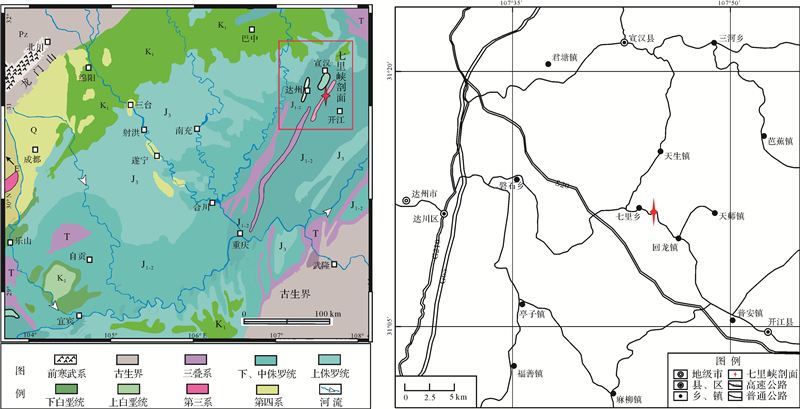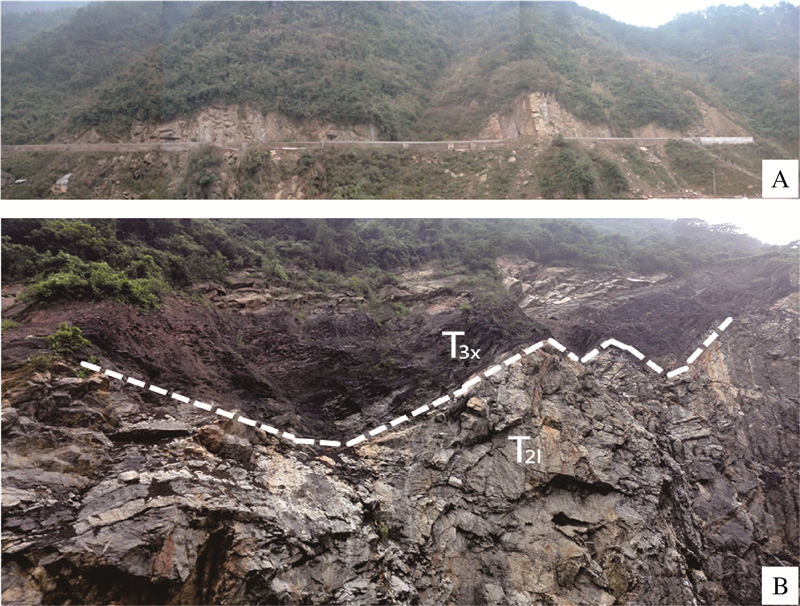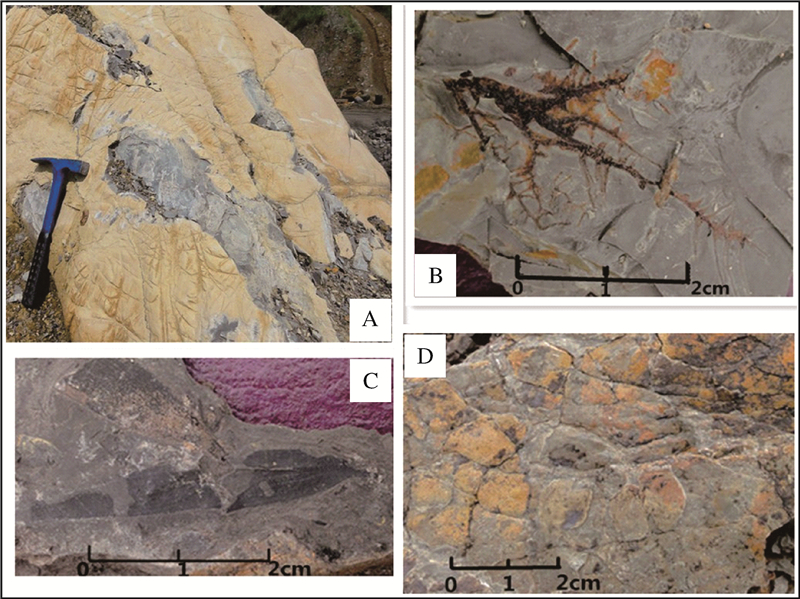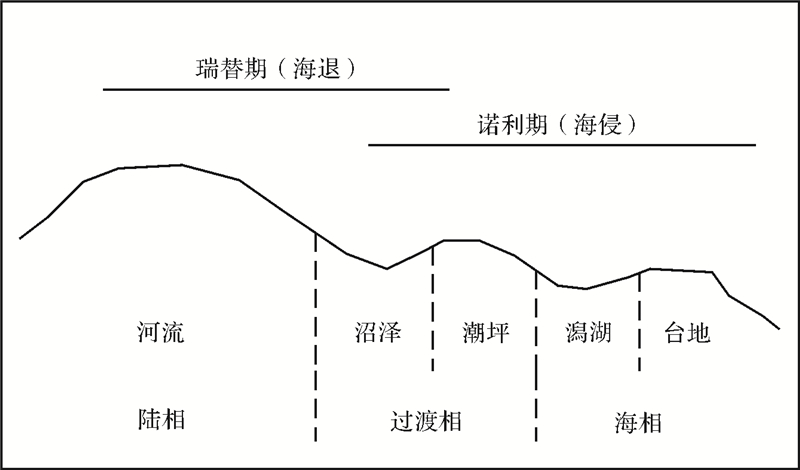扩展功能
文章信息
- 鲁宁, 谢小平, 王永栋, 李丽琴
- LU Ning, XIE XiaoPing, WANG YongDong, LI LiQin
- 四川宣汉七里峡T3x/T2l界线沉积环境演化分析
- The Analysis of Sedimentary Environmental Evolution of the T3x/T2l Boundary Transition in Qilixia of Xuanhan, Sichuan
- 沉积学报, 2015, 33(6): 1149-1158
- ACTA SEDIMENTOLOGICA SINCA, 2015, 33(6): 1149-1158
- 10.14027/j.cnki.cjxb.2015.06.008
-
文章历史
- 收稿日期: 2014-10-27
- 收修改稿日期: 2015-02-19
2. 中国科学院南京地质古生物研究所 南京 210008;
3. 中国科学院资源地层学与古地理学重点实验室 南京 210008;
4. 中国科学院大学 北京 100049
2. Nanjing Institute of Geology and Palaeontology, Chinese Academy of Sciences, Nanjing 210008;
3. Key Laboratory of Economic Stratigraphy and Palaeogeography, Chinese Academy of Sciences, Nanjing 210008;
4. University of Chinese Academy of Sciences, Beijing 100049
四川盆地地处中国大陆西南,范围在(28~32° N,103~108° E)之间,包括四川省的东部和重庆市的大部(图 1)。四川盆地发育有完整连续的晚震旦纪到第四纪的海相和陆相地层序列,出露一系列重要地质界线,特别是区内中—晚三叠世之交的海陆过渡相地层极为发育,保存了多条经典地层剖面,在区域地层对比、古环境重建以及油气资源勘探等相关研究中具有十分重要的参考价值[1]。

|
| 图 1 四川盆地三叠系—侏罗系地层分布及研究区宣汉七里峡剖面位置简图Fig. 1 Distribution of the Triassic and Jurassic deposits in the Sichuan Basin and the location of Qilixia Section in Xuanhan |
三叠系历来是四川盆地中生代地层研究的重点之一。最近几十年来,随着研究工作的不断深入,论述四川盆地中—上三叠统界线以及小塘子组、马鞍塘组和须家河组等过渡相地层层序划分、古植物与孢粉、沉积相与沉积旋回等研究成果不断发表[2, 3, 4, 5, 6, 7, 8, 9, 10, 11, 12, 13, 14],为区域性和全球性的陆相地层对比和油气资源勘探等方面提供了重要参考。2010年,王永栋等人编著的《四川盆地陆相三叠系与侏罗系》一书对此进行了系统总结[15]。
值得指出的是,由于受盆地构造演化的控制,四川盆地下—中三叠统为典型的海相地层,上三叠统则以陆相地层为主[15]。因此,区内的三叠系地层通常被分为海陆两部分分别进行研究[15]。在晚三叠世陆相地层及相关领域的研究方面,国内沉积学研究者对须家河组地层的聚煤特征和勘探意义关注度较高[6, 7],有力促进了四川盆地煤田和油气资源地质勘探工作的进一步深入开展;但是对中—晚三叠世之交及其晚三叠世的环境变化、地质事件等研究进展较为局限。尤其是对于中—上三叠统界线处的沉积学研究,包括印支运动时期的海平面升降、古地理环境演化、生物群落演替等内容关注较少。
近年来,笔者等对于四川盆地三叠—侏罗纪转换时期陆地生物多样性变化和古环境演变开展了多学科的专题研究,包括地层序列和代表性剖面、孢粉组合以及孢粉植物群和古植物等①,[14, 15, 16, 17]。本文在上述研究成果的基础上,结合野外实测和室内分析,重点对宣汉七里峡剖面中三叠统雷口坡组与上三叠统须家河组界线处(图 2)地层进行沉积相及沉积环境演化方面的研究,以期为区域地层对比和古环境重建以及古气候变化研究等提供参考。

|
|
图 2 四川宣汉七里剖面及其中—上三叠统界线 A.剖面概貌;B.中—上三叠统界线(T2l:中三叠统雷口坡组,T3x:上三叠统须家河组)Fig. 2 The Qilixia Section and the Middle-Upper Triassic boundary in Xuanhan of the Sichuan Basin. A. General view of the strata sequence; B. The Middle Triassic (T2l) and Upper Triassic (T3x) boundary |
①Li L Q,Wang Y D ,Liu Z S,et al. Late Triassic palaeoclimate and palaeoecosystem variations inferredby palynological record in the northeastern Sichuan Basin,China. Palontologische Zeitschrift,2015. (in press)
1 研究区概况及剖面描述 1.1 区域地质概况四川盆地的地质构造格局主要受北东—南西向及北西向两条构造线控制,整体呈现为自东北至西南的不规则菱形。在大地构造上作为上扬子地台一部分的四川盆地,自晋宁运动后便进入了稳定型地台建造期,震旦纪晚期至中三叠世发育了广阔的海相碳酸盐沉积;始于中三叠世拉丁期的印支早幕运动促成了泸州—开江古隆起的抬升,结束了区内大规模海域分布的历史,导致了中下三叠统地层的剥蚀,除了泸州地区尚有嘉陵江组残留外,盆地其余大部分地区的上三叠统须家河组地层与中三叠统雷口坡组接触,仅在盆地西缘有中三叠统上部天井山组和上三叠统下部的马鞍塘组、垮洪洞组分布[18]。
在盆地中部、东部以及南部地区,上三叠统须家河组地层普遍假整合于残留不全的中三叠统雷口坡组地层之上(表 1),以合川、广元、宣汉、达川、开江等剖面上较为典型。位于四川宣汉七里乡宣汉至开江公路界牌(31°11′50″ N,107°44′37″ E;海拔421 m)附近的宣汉七里峡剖面发育良好,出露完整连续且层序清晰,动植物化石丰富,无大的断裂构造,是较为理想的研究剖面。
宣汉七里峡上三叠统须家河组是一套含煤碎屑岩系,根据岩性、岩相和生物组合,可进一步划分为两个亚组七个岩性段[19](表 1)。其中须一段相当于诺利阶—瑞替阶界线[20],本文重点研究须一段与中三叠统雷口坡组界线处地层。
1.2 地层剖面描述剖面位于四川宣汉县川东八面山隔挡式褶皱带峨层山背斜北段七里峡峡谷的宣(汉)开(江)公路旁,地层出露完整连续且层序清晰,一至七段均有出露。根据野外实测数据并结合前人工作成果[5, 15, 22],该剖面须家河组一段地层层序如下(图 3,4):

|
|
图 3 中三叠统雷口坡组和上三叠统须家河组一段部分沉积特征及化石 A.中三叠统雷口坡组白云岩的刀砍状构造;B.植物根系化石;C.植物叶片化石;D.泥裂构造Fig. 3 Sedimentary characteristics and fossils in the Middle Triassic Leikoupo Formation and the 1st member of the Upper Triassic Xujiahe Formation of the Qilixia Section, Xuhan, Sichuan |

|
| 图 4 四川宣汉七里峡上三叠统须家河组一段岩性及沉积相综合柱状图Fig. 4 Generalized column of the lithologic section and sedimentary facies for the 1st member of the Upper Triassic Xujiahe Formation of the Qilixia Section, Xuhan, Sichuan |
上覆地层:上三叠统须家河组第二段
8.浅灰色细—中粒砂岩、长石质杂砂岩,显斜层理。上部夹薄层砾岩和粉砂质微晶灰岩;底部含泥质、铁质包体,产植物化石碎片。203.6 m

上三叠统须家河组第一段
7b.深灰—黑灰色薄层泥岩、页岩,夹2层钙质条带,并有菱铁矿结核条带出现。采集孢粉化石样品:
QLX-4。 7.3 m
7a.深灰—黑色薄层炭质泥岩、页岩,夹十余层薄煤层,含植物化石:Neocalamites sp.,Leptopteris sp. Dictyophyllum sp.,Phlebopteris sp.,Podozamites sp.等。采集孢粉化石样品:QLX-3。 17.2 m
6.深灰色泥岩,根土岩发育,含植物化石碎片。采集孢粉化石样品:QLX-2。 70 cm
5.灰色薄层砂质泥岩,水平纹层发育,泥裂极发育。含植物化石碎片,根系发育且斜穿岩层。 15 cm
4.灰色薄层粉砂质泥岩,偶夹薄层石膏;表面风化,黄褐色铁质遗迹较多。 140 cm
3.深灰色钙质泥岩,水平纹层发育。采集孢粉化石样品:QLX-1。 70 cm
2.黄棕色铁质结核层。 15 cm

中三叠统雷口坡组第一段
1.灰色厚层状泥晶白云岩,表面具刀砍状纹理。 未见底
1.3 剖面孢粉学研究须一段采集孢粉化石样品四个,编号依次为QLX-1,QLX-2,QLX-3,QLX-4。对孢粉化石样本进行分析,其中QLX-4号样品不含孢粉化石,详细数据见表 2。
| 类别 | 孢子属种 | 特征分析 |
| 蕨类植物孢子 | Cyathidites minor, Deltoidospora minor, Toroisporis sp ., Dictyophyllidites harrisii, D. intercrassus, Concavisporites toralis, Punctatisporites triassicus, P. sp ., Lunzisporites lunzensis, L. sparsus, L. pallidus, Grannulatisporites sp ., Angiopteridaspora denticulata, Baculatisporites comaumensis, Lophotriletes microsaetosus, Osmundacidites wellmanii, Neoraistrickia taylorii, Anapiculatisporites cooksonae, Apiculatisporis spiniger, A. sp ., Cyclogranisporites sp ., Verrucosisporites sp ., Lycopodiacidites minus, L. rudis, Lycopodiumsporites austroclavatidites, Annulispora folliculosa, A. microanulata, Klukisporites variegatus, K. pseudoreticulatus, Kraeuselisporites punctatus, Kyrtomisporis sp ., Densoisporites velatus, Asseretospora scanica, Aratrisporites fischeri, A. scabratus, A. tenuispinosus | 1.蕨类植物孢子数量最多;其次是裸子植物花粉;并含有少量苔藓类植物孢子及藻类化石。 |
| 裸子植物花粉 | Psophosphaera minor, Cycadopites subgranulosus, C. reticulatus, C. mugnus, C. deterius, C. parvus, Chasmatosporites apertus, C. hians, C. major, C. minor, C. triangularis, Cerebropollenites mesozoicus, Cordaitina sp ., Taeniaesporites albertae, Quadraeculina anellaeformis, Q. limbata, Q. minor, Vitreisporites palloidus, Piceites enodis, Alisporites australis, A. parvus, Pseudopicea variabiliformis, Abietineaepollenites pectinellus, A. cavernosa, Pinuspollenites divulgatus, P. alatiopollenites, P. minutus, P. globosaccus, P. elongates, Podocarpidites multesimus, P. multicinus,Platysaccus papilionis 等。 | 2.蕨类植物孢子主要是双扇蕨科孢子。 |
| 苔藓及藻类 | Stereisporites perforatus,S. apolaris; Sulcusicystis sp.等。 | 3.裸子植物花粉主要是松柏类及苏铁类。 |
研究剖面的岩石类型以深灰—黑色泥页岩为主,砂质、粉砂质泥岩较少,不含砾岩沉积。其中泥页岩类约占剖面厚度的94.4%,砂质粉砂质泥岩约占5.6%。泥页岩主要是炭质泥页岩,约占剖面厚度的62.3%,而炭质泥页岩一般是湖泊沼泽、海滨沼泽产物;剖面近底部发育一层钙质泥岩,结合剖面整体岩性,应为海洋、澙湖产物。碳酸盐岩主要以菱铁矿结核条带状或透镜状产出,仅占研究剖面厚度0.6%左右。
2.2 沉积相标志 2.2.1 颜色沉积岩的颜色是由沉积岩中色素所决定的直观而显著的标志,并与沉积环境条件密切相关。研究剖面沉积岩颜色主要以灰、深灰和黑色为主,主要因其有机质(炭质)含量较高,而炭质则与沼泽环境有关,结合其物质组成,说明当时应为湿润气候条件下的还原性沉积环境。
2.2.2 构造沉积岩的构造是反映沉积岩生成存在条件的重要特征之一,按其成因可分为机械构造、化学构造和生物构造。在沉积作用为主的过程中形成的层理和层面构造等机械成因构造是水动力条件的物质表现,在古环境重建中具有十分重要的意义[23]。
(1) 层理,研究剖面主要表现出块状层理和水平层理。
块状层理是在平静水体(Fr<<1)中单一物质垂向加积或粗碎屑未经分选而快速堆积的结果,常见于泥质岩层和砂岩层中。见块状层理泥质岩层表征澙湖、湖泊、前三角洲等环境,见块状层理砂岩层则表征河口砂坝、河流等环境[24]。研究剖面块状层理主要由根土岩产出,并含有大量植物化石碎片,应为澙湖—沼泽环境。
水平层理是在Fr<<<1的极微弱水动力条件或者静水环境中,细碎屑物质低速下落垂向加积而成的毫米级细层,呈直线型相互平行,连续或断续状[24]。研究剖面主要因其有机质含量、粒度大小的不同表现出水平纹层,岩性主要是泥岩和页岩,层面含较多植物化石碎片。
(2) 层面构造,研究剖面主要表现出泥裂。
泥裂是沉积物在未充分固结的情况下露出水面,因水分快速蒸发而干涸开裂时所形成的裂缝状构造。常见于泥岩、粉砂岩以及碳酸盐岩中,表征大陆和滨海环境,特别是河漫滩、潮汐坪地和浅滩。代表沉积物露出水面的重要特征。
2.2.3 古生物及聚煤特征生物的生存、演化和易受环境因素的影响,因而古生物化石与聚煤特征可以作为古环境温度和湿度的有效指标。
研究剖面的晚三叠世须家河组产丰富的植物化石和孢粉化石。其中须家河组第一段的植物化石类型较少,主要是有节类Equisetites,Neocalamites、真蕨类Cladophlebis,以及苏铁类和松柏类等。以有节类和真蕨类为主,代表潮湿到半潮湿气候;双扇蕨科、马通蕨科及苏铁类繁盛又反映气候温暖,属于热带、亚热带型的气候[6]。孢粉数据表明,研究剖面须一段以蕨类植物孢子数量最多,其次是裸子植物花粉,并含有少量苔藓类植物孢子及藻类化石。蕨类植物孢子主要是双扇蕨科孢子;裸子植物花粉主要是松柏类及苏铁类。这样的孢粉组合表征的植被面貌属于热带—亚热带植被类型[17, 18, 25]。
泥炭的堆积和保存需要足够高的水位以覆盖正在腐烂的植物并防止其被氧化,同时水位又要足够的低以确保活着的植物不被淹没死亡。煤层的厚度受可容空间增加速率与泥炭堆积速率的控制[26]。研究剖面含煤性差,煤层以薄煤层或煤线状产出,富含菱铁矿结核,不具工业开采价值,说明陆源碎屑物质供给足以破坏聚煤作用所依赖的还原环境。同时,多层薄煤层的形成也说明研究剖面沉积时期经历了水平面的多次升降,但气候总体上还是较为湿热。
2.2.4 包体类型及意义研究剖面中所含包裹体主要是菱铁矿、石膏和钙质结核。
菱铁矿一般在陆源碎屑物质较少而生物产率较高的浅海或盐度正常的澙湖中生成[27],多以结核状、薄层状产出于沉积岩,特别是煤系地层的泥质与粉砂质岩层中。研究剖面的菱铁矿以薄层条带状产出,分带特征明显,据此可知应具有一定水深条件。
石膏一般是高浓度卤水中沉淀的原生硫酸钙矿物,其持续沉淀要求Ca2+、SO2-4的过饱和溶液中Ca2+、SO2-4不断补充或H2O的不断减少[28]。研究表明石膏的沉积主要是在封闭或半封闭的还原性浅水环境中通过气—液界面的蒸发作用而达到[23]。研究剖面的石膏主要以薄层状或透镜状产出,结合第4层层面风化且发育铁质遗迹,说明在第4层沉积时期,蒸发作用极其显著,水深迅速下降,并在沉积末期出露接受风化。
钙质结核主要是由碳酸钙组成的结核状表生成岩期矿物,其形成与地下水的上升、蒸发、沉淀作用有关,可作为早期暴露的一种鉴定标志[23]。现代研究表明在有利的沉积介质和地形条件下,其形成一般表征了地质气候的短期交替,通常为温度较高、气候炎热且蒸发量较大的淡水环境条件[29]。结合研究剖面7a层—7b层岩性由炭质泥页岩转变为普通泥页岩,有机质含量降低也说明在须一段沉积末期气候发生了短期变化。
2.2.5 有机碳同位素特征须家河组泥岩段的有机碳同位素测试数据表明[20],七里峡剖面的δ13Corg基值为-25‰,在一段存在幅度达15‰~18‰的极度正偏,具有区域上的可识别性。结合国外相关研究[30],四川盆地东缘须一段地层应当在诺利期末期至瑞替期初期前后开始沉积。
2.3 沉积相划分通过对野外剖面的实地测量,结合岩石类型、沉积构造、古生物及孢粉和有机碳同位素等数据分析,对宣汉七里峡剖面须一段的沉积相及沉积环境分析,结果如图 4所示。并详细描述如下。
剖面底部(即本文所划分1层)为中三叠统雷口坡组一段灰色厚层状泥晶白云岩,为蒸发台地微相。须家河组一段发育典型的海陆过渡相沉积。剖面下部(主要是2~6层)发育滨浅海平原亚相,其中2~5层发育澙湖潮坪微相,第6层为潮上泥坪微相;剖面中部(即7a层)发育典型的滨岸沼泽环境下的泥炭沼泽微相;剖面上部(即7b层)发育滨湖沼泽微相。上覆地层须家河组二段下部为河口砂坝微相。岩层韵律和沉积相演变显示了典型的海侵—海退旋回(图 5)。

|
| 图 5 四川宣汉七里峡中—上三叠统之交的沉积模式图Fig. 5 The sedimentary facies and evolutionary patterns of the Middle and Upper Triassic transition for the Qilixia Section,Xuanhan,Sichuan |
沉积相是沉积物形成条件即古环境条件的物质表现,而沉积模式则是根据现代沉积环境及古代沉积相的研究,对古代沉积作用机理所作的成因解释模型。本文以刘宝珺关于沉积环境的分类和常见相及形成环境为依据,结合沉积物类型及特征、水动力特点、古生物化石及聚煤特征和古地貌进行沉积模式综合分析[23]。
宣汉七里峡地区在中三叠世拉丁期随开江古隆起抬升以后,结束了早期海域历史,中三叠统地层剥蚀殆尽,研究剖面仅能观察到雷口坡组一段部分地层残余。结合前人对马鞍塘组、小塘子组地层的研究[8, 31, 32, 33, 34, 35],研究剖面的沉积模式表明,始于晚三叠世卡尼期的持续海侵过程,直到诺利期后期才到达宣汉地区,并在川东北地区形成了障壁型河口海湾环境,发育澙湖潮坪和潮上泥坪沉积微相。诺利期末期,随着华北古陆的挤压和秦岭造山带的影响,宣汉地区的海水开始退出,并在川东北地区形成了滨海—滨湖沼泽环境,发育泥炭沼泽—滨湖沼泽沉积微相。进入瑞替期,海水完全退出川东北地区,来自大巴山区的碎屑沉积物质开始占据统治地位,发育一套典型陆相含煤地层。
须一段沉积时期,即诺利期末期至瑞替期初期,宣汉地区形成了以有节类和真蕨类为主,特别是双扇蕨科、马通蕨科和苏铁类繁盛的沼泽湿生植物群落,反映了属于热带、亚热带海湾沿岸低地小型植物草本、灌木丛生境。在须一段沉积末期,宣汉地区气候曾出现短暂向干燥气候的更替,第7b层沉积物中的钙质结核说明了这点。
郭正吾等对上扬子地区构造演化,特别是印支运动的研究[7, 8, 32, 35, 36, 37, 38]表明,晚三叠世是四川盆地海陆转换的重要时期。进入晚三叠世,在龙门山造山带崛起的影响下,扬子地台西缘发生沉降,海侵并沉积海相的马鞍塘组和海陆过渡相的小塘子组(即须一段)。之后受秦岭—大巴造山带大规模崛起的影响,海水大规模向西退出四川盆地,并开始了四川盆地的陆相沉积历史。这与本文的分析结果相吻合。
李佩娟、叶美娜、黄其胜等人对川东北地区植物群和古气候的研究[2, 4, 5, 6, 10, 25]表明,川东地区须家河植物群以真蕨和苏铁类为主,属沿岸水生和沼泽湿生植物群落,反映了当时炎热潮湿的气候特点。这与本文对孢粉和植物化石的分析结果相一致。
4 结论通过对宣汉七里峡剖面的实测及分析工作,对宣汉地区诺利期末期至瑞替期初期的沉积环境以及地层层序和沉积相进行了详细划分和研究。宣汉地区在这一时期主要发育滨浅海环境下的澙湖潮坪相和滨岸沼泽相沉积,下伏中三叠统雷口坡组发育蒸发台地相沉积,上覆须家河组二段发育河口砂坝相沉积。
对须一段地层的系统分析研究表明:本段地层以深灰—黑色泥页岩为主,砂质、粉砂质泥岩较少,不含砾岩沉积;沉积厚度不大,一般为水平层理,斜层理不发育,泥裂极发育;沉积物中含有大量植物遗体,见植物根化石,含钙质结核和菱铁矿结核,局部可见石膏。自下而上依次为菱铁矿结核层、钙质泥岩层、粉砂质泥岩层、砂质泥岩层、泥岩层、炭质泥页岩层(夹薄煤层数层)和泥页岩层6个不同的岩性层。
研究表明,四川盆地在经历了中三叠世拉丁期的大规模海退后,自晚三叠世卡尼期又发生了向东、向北、向南的大规模海侵,并在诺利期末期发生了自北东而南西的再一次大规模海退。对须一段沉积模式的重建表明:迟至诺利期后期,四川盆地的持续海侵到达并开始影响本区,在本区形成了障壁型河口海湾环境,并短暂发育海湾澙湖环境下的澙湖潮坪相沉积。而后随着诺利期末期的再次海退,本区率先退出了海域范围,在残留沼泽环境中迅速发育泥炭沼泽和滨湖沼泽相沉积。并在进入瑞替期后迅速转变为陆相河流环境下的河口砂坝相沉积。
| [1] | 四川省地方志编纂委员会. 四川省志-地质志[M]. 成都:四川人民出版社, 1998.[Compiling Committee of Sichuan Chorography. Chorography of Sichuan Province, Geological Memoir[M]. Chengdu:Sichuan People's Publishing House, 1998.] |
| [2] | 李佩娟. 四川广元须家河组植物化石[C]//中国科学院南京地质古生物研究所集刊. 第3号. 北京:科学出版社, 1964:105-158.[Li Peijuan. Fossil plants from the Hsuchiaho Series of Kwangyuan, Northern Szechuan[C]//Memoirs of the Institute of Geology & Paleontology. Academia Sinica, 3. Beijing:Science Press, 1964:105-158.] |
| [3] | 陈楚震, 黎文本, 马其鸿, 等. 西南地区的三叠系[M]//中国科学院南京地质古生物研究所. 西南地区碳酸盐生物地层. 北京:科学出版社, 1979:289-336.[Chen Chuzhen, Li Wenben, Ma Qihong, et al. Triassic strata of SW China[M]//Nanjing Institute of Geology and Paleontology. Carbonate biostratigraphy of SW China. Beijing:Science Press, 1979:289-336.] |
| [4] | 叶美娜, 刘兴义, 黄国清, 等. 川东北地区晚三叠世及早、中侏罗世植物[M]. 合肥:安徽科学技术出版社, 1986.[Ye Meina, Liu Xingyi, Huang Guoqing, et al. Late Triassic and Early-Middle Jurassic fossil plants from northeastern Sichuan[M]. Hefei:Anhui Science and Technology Publishing House, 1986.] |
| [5] | 黄其胜, 鲁胜梅. 川东地区晚三叠世须家河植物群古生态初探[J]. 地球科学, 1992, 17(3):329-335.[Huang Qisheng, Lu Shengmei. The primary studies on the palaeoecology of the Late Triassic Xujiahe flora in eastern Sichuan[J]. Earth Science, 1992, 17(3):329-335.] |
| [6] | 黄其胜. 川北晚三叠世须家河期古气候及成煤特征[J]. 地质论评, 1995, 41(1):92-99.[Huang Qisheng. Paleoclimate and coal-forming characteristics of the Late Triassic Xujiahe Stage in northern Sichuan[J]. Geological Review, 1995, 41(1):92-99.] |
| [7] | 郭旭升. 川西地区中、晚三叠世岩相古地理演化及勘探意义[J]. 石油与天然气地质, 2010, 31(5):610-619, 631.[Guo Xusheng. Litho-paleogeographic evolution in the Middle-Late Triassic in western Sichuan province and its significance for petroleum exploration[J]. Oil & Gas Geology, 2010, 31(5):610-619, 631.] |
| [8] | 时志强, 张华, 曾德勇, 等. 龙门山前缘上三叠统卡尼阶特征及其古环境、古气候意义[J]. 成都理工大学学报:自然科学版, 2010, 37(4):424-431.[Shi Zhiqiang, Zhang Hua, Zeng Deyong, et al. Characters of Carnian in the frontal area of Mt. Longmenshan:implications for palaeoenvironment and paleoclimate[J]. Journal of Chengdu University of Technology:Science & Technology Edition, 2010, 37(4):424-431.] |
| [9] | 苟宗海. 四川龙门山中段上三叠统须家河组特征[J]. 沉积与特提斯地质, 2001, 21(1):93-101.[Gou Zonghai. The Upper Triassic Xujiahe Formation in the Longmen Mountain area, Sichuan[J]. Sedimentary Geology and Tethyan Geology, 2001, 21(1):93-101.] |
| [10] | 王全伟, 阚泽忠, 刘啸虎, 等. 四川中生代陆相盆地孢粉组合所反映的古植被与古气候特征[J]. 四川地质学报, 2008, 28(2):89-95.[Wang Quanwei, Kan Zezhong, Liu Xiaohu, et al. The Mesozoic sporopollen assemblage in the Sichuan Basin and its significance to paleovegetation and paleoclimate[J]. Acta Geologica Sichuan, 2008, 28(2):89-95.] |
| [11] | 郑荣才, 朱如凯, 戴朝成, 等. 川东北类前陆盆地须家河组盆-山耦合过程的沉积-层序特征[J]. 地质学报, 2008, 82(8):1077-1087.[Zheng Rongcai, Zhu Rukai, Dai Chaocheng, et al. Depositional sequence features during coupling process between basin and mountain of the Xujiahe Formation of Upper Triassic in the foreland basin, NE Sichuan[J]. Acta Geologica Sinica, 2008, 82(8):1077-1087.] |
| [12] | 丘东洲. 四川盆地西部坳陷晚三叠世-早白垩世地层沉积相[J]. 四川地质学报, 2000, 20(3):161-170.[Qiu Dongzhou. Sedimentary facies of the Upper Triassic-Lower Cretaceous of the west Sichuan Basin depression[J]. Acta Geologica Sichuan, 2000, 20(3):161-170.] |
| [13] | 闫臻, 俞良军, 李继亮, 等. 松潘-若尔盖地区中-上三叠统沉积相组合特征[J]. 自然科学进展, 2007, 17(2):196-204.[Yan Zhen, Yu Liangjun, Li Jiliang, et al. Combined Sedimentary facies of the Middle-Upper Triassic in Songpan-Ruoergai region[J]. Progress in Natural Science, 2007, 17(2):196-204.] |
| [14] | 刘兆生, 李丽琴, 王永栋. 重庆合川地区晚三叠世须家河组孢粉组合[J]. 古生物学报, 2015, 54(3):279-304.[Liu Zhaosheng, Li Liqin, Wang Yongdong. Late Triassic spore-pollen assemblage from the Xujiahe Formation in Hechuan of Chongqing, China[J]. Acta Palaeontologica Sinica, 2015, 54(3):279-304.] |
| [15] | 王永栋, 付碧宏, 谢小平, 等. 四川盆地陆相三叠系与侏罗系[M]. 合肥:中国科学技术大学出版社, 2010.[Wang Yongdong, Fu Bihong, Xie Xiaoping, et al. The Terrestrial Triassic and Jurassic Systems in the Sichuan Basin, China[M]. Hefei:University of Science & Technology of China Press, 2010.] |
| [16] | Wang Y D, Li L Q, Guignard G, et al. Fertile structures with in situ spores of a dipterid fern from the Triassic in southern China[J]. Journal of Plant Research, 2015, 128(3):445-457. |
| [17] | 刘兆生, 李丽琴, 王永栋. 四川宣汉晚三叠世孢粉组合及其古植被和古气候意义[J]. 微体古生物学报, 2015, 32(1):43-62.[Liu Zhaosheng, Li liqin, Wang Yongdong, Late Triassic palynological assemblage from Xuanhan of Sichuan, China[J]. ActaMicropalaeontologicaSinica, 2015, 32(1):43-62.] |
| [18] | 刘啸虎, 周萍青. 上三叠统[M]//四川盆地陆相中生代地层古生物编写组. 四川盆地陆相中生代地层古生物(上篇)地层. 成都:四川人民出版社, 1982:5-56.[Liu Xiaohu, Zhou Pingqing. Continental Mesozoic stratigraphy and paleontology in Sichuan Basin of China, Part I:Stratigraphy, Chapter I. Upper Triassic System[M]. Chengdu:Sichuan People's Publishing House, 1982:5-56.] |
| [19] | 殷鸿福, 杨逢清, 黄其胜, 等. 秦岭及邻区三叠系[M]. 武汉:中国地质大学出版社, 1992:77-84, 88-92.[Yin Hongfu, Yang Fengqing, Huang Qisheng, et al. The Triassic of Qinling Mountains and Neighboring Areas[M]. Wuhan:China University of Geosciences Press, 1992:77-84, 88-92.] |
| [20] | 卢远征, 李鑫, 邓胜徽, 等. 四川盆地东缘晚三叠世须家河组孢粉和有机碳同位素研究进展[J]. 地层学杂志, 2013, 37(4):584-585.[Lu Yuanzheng, Li Xin, Deng Shenghui, et al. Research progress in sporopollen and carbon isotope of the Late Triassic Xujiahe Formation in eastern Sichuan Basin[J]. Journal of Stratigraphy, 2013, 37(4):584-585.] |
| [21] | 蒋裕强, 陶艳忠, 沈妍婓, 等. 对大川中地区上三叠统须家河组二、四、六段砂岩沉积相的再认识[J]. 天然气工业, 2011, 31(9):39-50.[Jiang Yuqiang, Tao Yanzhong, Shen Yanfei, et al. A new understanding of sedimentary facies of sandstones in the 2nd, 4th, and 6th members of the Upper Triassic Xujiahe Formation in the Large-Scale Middle Sichuan Basin[J]. Natural Gas Industry, 2011, 31(9):39-50.] |
| [22] | 黄东, 张健, 杨光, 等. 四川盆地中三叠统雷口坡组地层划分探讨[J]. 西南石油大学学报:自然科学版, 2011, 33(3):89-95.[Huang Dong, Zhang Jian, Yang Guang, et al. The discussion of stratum division and stratum for the Leikoupo Formation of Middle Triassic in Sichuan Basin[J].. Journal of Southwest Petroleum University:Science & Technology Edition, 2011, 33(3):89-95] |
| [23] | 刘宝珺. 沉积岩石学[M]. 北京:地质出版社, 1980.[Liu Baojun. Sedimentary Lithology[M]. Beijing:Geological Publishing House, 1980.] |
| [24] | 谢小平, 王永栋, 沈焕庭. 宁夏中卫晚石炭世沉积相分析与古环境重建[J]. 沉积学报, 2004, 22(1):19-28.[Xie Xiaoping, Wang Yongdong, Shen Huanting. Facies analysis and sedimentary environment reconstruction of the Late Carboniferous in Zhongwei, Ningxia[J]. Acta Sedimentologica Sinica, 2004, 22(1):19-28.] |
| [25] | 李丽琴, 王永栋. 四川宣汉晚三叠世孢粉植物群及古环境意义[C]//中国古生物学会第十一次全国代表大会暨第27届学术年会论文摘要集. 中国古生物学会. 北京:中国科学院大学, 2013:151.[Li Liqin, Wang Yongdong. The Late Triassic palynoflora and their palaeoenvironmental significance in Xuanhan of Sichuan, southwestern China[C]//The 11th National Congress of the Palaeontological Society of China(PSC) and the 27th Annual Conferrence of PSC, Abstract Volume. Palaeontological Society of China. Beijing:University of Chinese Academy of Sciences, 2013:151.] |
| [26] | 高彩霞, 邵龙义, 李长林, 等. 四川盆地东部上三叠统须家河组层序地层及聚煤特征研究[J]. 古地理学报, 2009, 11(6):689-696.[Gao Caixia, Shao Longyi, Li Changlin, et al. Sequence stratigraphy and coal accumulation of the Upper Triassic Xujiahe Formation in eastern Sichuan Basin[J]. Journal of Palaeogeography, 2009, 11(6):689-696.] |
| [27] | 谢小平, 佟再三, 沈焕庭. 甘肃景泰红水堡晚石炭世沉积环境与沉积相分析[J]. 沉积学报, 2003, 21(3):381-390.[Xie Xiaoping, Tong Zaisan, Shen Huanting. Analysis on sedimentary environment and facies in Later Carboniferous Epoch of Hongshuibao, Jingtai county, Gansu province[J]. Acta Sedimentologica Sinica, 2003, 21(3):381-390.] |
| [28] | 黄光煦. 内陆湖盆石膏沉积作用浅析[J]. 非金属矿, 1986(4):5-7.[Huang Guangxu. Study on the gypsum in the inland lake basin[J]. Non-Metallic Mines, 1986(4):5-7.] |
| [29] | 钟福平, 钟建华, 由伟丰, 等. 贺兰山汝箕沟三叠纪钙质结核特征及环境意义[J]. 大庆石油学院学报, 2011, 35(1):26-29.[Zhong Fuping, Zhong Jianhua, You Weifeng, et al. Characteristics and environmental significance of the calcareous coneretions in Rujigou of Helan mountain[J]. Journal of Daqing Petroleum Institute, 2011, 35(1):26-29.] |
| [30] | Sephton M A, Amor K, Franchi, et al. Carbon and nitrogen isotope disturbances and an end-Norian(Late Triassic) extinction event[J]. Geology, 2002, 30(12):1119-1122. |
| [31] | 施振声, 赵正望, 金惠, 等. 四川盆地上三叠统小塘子组沉积特征及地质意义[J]. 古地理学报, 2012, 14(4):477-486.[Shi Zhensheng, Zhao Zhengwang, Jin Hui, et al. Depositional characteristics and its geological significance of the Upper Triassic Xiaotangzi Formation in Sichuan Basin[J]. Journal of Palaeogeography, 2012, 14(4):477-486.] |
| [32] | 杨荣军, 刘树根, 吴熙纯, 等. 龙门山前缘上三叠统马鞍塘组沉积分布特征及其控制因素[J]. 成都理工大学学报:自然科学版, 2008, 35(4):455-462.[Yang Rongjun, Liu Shugen, Wu Xichun, et al. Distribution characteristics and controlling factors of Upper Triassic Ma'antang Formation in the front of Longmen Mountains, Sichuan, China[J]. Journal of Chengdu University of Technology:Science & Technology Edition, 2008, 35(4):455-462.] |
| [33] | 邹光富, 夏彤, 楼雄英. 四川广元地区上三叠统小塘子组、须家河组层序地层研究[J]. 沉积与特提斯地质, 2003, 23(3):73-80.[Zou Guangfu, Xia Tong, Lou Xiongying. Sequence stratigraphy of the Late Triassic strata in the Guangyuan region, Sichuan[J]. Sedimentary Geology and Tethyan Geology, 2003, 23(3):73-80.] |
| [34] | 赵玉峰, 赵兵. 四川江油马鞍塘中晚三叠世沉积相及层序地层分析[J]. 沉积与特提斯地质, 2008, 28(2):96-99.[Zhao Yufeng, Zhao Bing. Middle-Late Triassic sequence stratigraphic framework and sedimentary facies in the Ma'antang section, Jiangyou, Sichuan[J]. Sedimentary Geology and Tethyan Geology, 2008, 28(2):96-99.] |
| [35] | 梅冥相. 中上扬子印支运动的地层学效应及晚三叠世沉积盆地格局[J]. 地学前缘, 2010, 17(4):99-111.[Mei Mingxiang. Stratigraphic impact of the Indo-China Movement and its related evolution of sedimentary-basin pattern of the Late Triassic in the Middle-Upper Yangtze region, South China[J]. Earth Science Frontiers, 2010, 17(4):99-111.] |
| [36] | 贾承造, 李本亮, 张兴阳, 等. 中国海相盆地的形成与演化[J]. 科学通报, 2007, 52(S1):1-8.[Jia Chengzao, Li Benliang, Zhang Xingyang, et al. Formation and evolution of the Chinese marine basin[J]. Science Bulletin, 2007, 52(S1):1-8.] |
| [37] | 郭正吾, 邓康龄, 韩永辉, 等. 四川盆地形成与演化[M]. 北京:地质出版社, 1996:113-138.[Guo Zhengwu, Deng Kangling, Han Yonghui, et al. The Formation and Evolution of Sichuan Basin[M]. Beijing:Geological Publishing House, 1996:113-138.] |
| [38] | Li Yong, Allen P A, Densmorel A L, et al. Evolution of the Longmenshan foreland basin(Western Sichuan, China) during the Late Triassic indosinian orogeny[J]. Basin Research, 2003, 15(1):117-138.] |
 2015, Vol. 33
2015, Vol. 33


